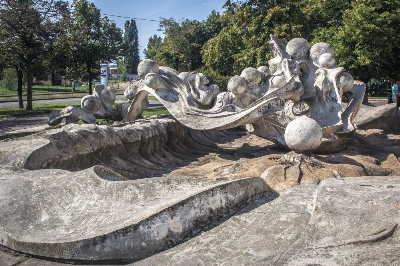
©
У Києві нове життя отримала монументальна скульптура «Водограй», розташована в спальному районі Троєщина біля кінотеатру «Флоренція». Ініціативу з оновлення об’єкта реалізувала група молодих художників, дослідників радянського модернізму та урбаністів. Автор скульптури — Ернест Котков (1931–2012), видатний український монументаліст, живописець, скульптор і дизайнер. Один із провідних представників «київської школи» монументального мистецтва, Котков відіграв важливу роль у формуванні візуального образу як радянської, так і пострадянської України. Його творчість поєднувала архітектуру, живопис, мозаїку, скульптуру та декоративне оформлення в єдиний мистецький простір. «Водограй» — яскрава мозаїчна абстракція, що нагадує квітку або фантастичну рослину, що виростає із землі — є характерним зразком естетики пізнього радянського модернізму. Відновлена робота стала не лише прикладом збереження спадщини, а й важливою частиною міського ландшафту. На Троєщині збереглися ще дві роботи Коткова: «Пам’яті жертв Чорнобиля» та «Букет» (пам’яті Володимира Висоцького), створені в 1986–1988 роках. Разом вони утворюють монументальний триптих, що зберігає колективну пам’ять у міському просторі столиці.
Kyiv’s “Vodohrai” Fountain Restored as a Symbol of Soviet-Era Troieshchyna
In a powerful gesture of cultural restoration, a collective of young artists, researchers of Soviet modernism, and urbanists has come together to revive Vodohrai — a monumental sculpture located in Kyiv’s residential district of Troieshchyna, near the Florence Cinema. The piece was originally created by Ernest Kotkov (1931–2012), a prominent Ukrainian monumental artist, painter, sculptor, and designer. A key figure of the so-called “Kyiv School” of monumental art, Kotkov was instrumental in shaping the visual language of both Soviet and post-Soviet Ukraine. His approach — a fusion of architecture, painting, mosaic, sculpture, and decorative design — reflected a broader ambition to synthesize the arts into cohesive public forms. Vodohrai, a striking mosaic-clad abstract composition, resembles a blooming flower or a fantastical plant emerging from the earth — a signature aesthetic of late Soviet modernism. The fountain, now reanimated by a new generation, embodies the enduring legacy of public art in Kyiv’s urban fabric. Two additional works by Kotkov remain in the Troieshchyna district: In Memory of the Victims of Chornobyl and Bouquet (dedicated to Vladimir Vysotsky), both created between 1986 and 1988. Together, these sculptures form a lasting tribute to a period in Ukrainian art when monumental design met collective memory in the city’s most populous neighborhoods.
1473